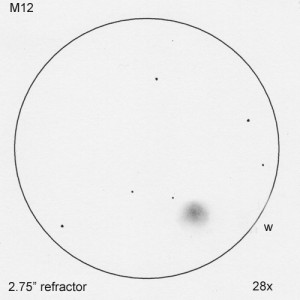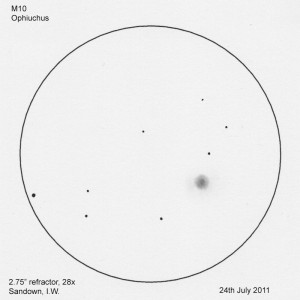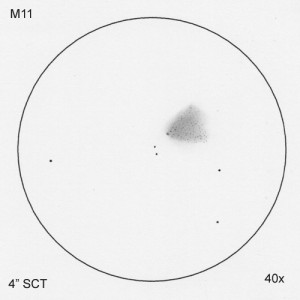The dark nights are back, if only for a couple of hours each night, and the nights are drawing in at last. Last night, 24th July, was clear although not perfect so I took my small scopes out instead of getting the 12″ out. Another reason for this was that I wanted to see what the little ones could do on the globular clusters of Ophiuchus.
Date: 24th July 2011
Conditions: Clear, 87% humidity (very dewy), 12° C
NELM: 6.0 decreasing to 5.8 later on.
Transparency: III. Clear, some haze visible. Milky Way still visible but not detailed
Seeing: II
Equipment: 2.75″ (70mm) f/6 Vixen refractor; 4″ (102mm) Meade SCT, 8×42 binoculars; 40mm Televue Plossl, 25mm Televue Plossl, 15mm Televue Plossl.
NGC 6218 (= M12), globular cluster in Ophiuchus -Large and bright. Not resolved in little scope but granular with averted vision. The g.c. has a brighter centre and an irregular shape. 2.75″ refractor with 15mm Plossl (28x).
NGC 6254 (=M10), globular cluster in Ophiuchus – Smaller and slightly brighter than M12. Denser than M12 with a brighter denser core. Round. Unresolved. 2.75″ refractor with 15mm Plossl (28x).
NGC 6426, globular cluster in Ophiuchus – Not seen.
NGC 6366, globular cluster in Ophiuchus – Not seen.
NGC 6705 (=M11), open cluster in Scutum – Visible to the unaided eye and as a bright detached nebulous patch in the Scutum Star Cloud through the 8×42 binoculars. In the 4″ SCT it is a bright, rich, fan shaped cluster. With direct vision it just looks nebulous but with averted vision there are many stars, although there is still a nebulous background. There is a bright star on the eastern point of the ‘fan’. 4″ SCT, 25mm TV Plossl (40x).
NGC 6402 (=M14), globular cluster in Ophiuchus – Round, not resolved. Slightly brighter towards the centre. 8×42 bin.
The scopes were dewing up badly as neither have dew caps so, as it was 1am, I packed up. While I’d rather be doing some more ‘serious’ observing (for want of a better expression), just going outside and using tiny scopes and binoculars to see what can be picked up is fun and can be suprisingly productive.
——————————————————————————————————————————————-
The little Vixen 2.75″ is a nice little rich field scope and it’s easy to find things with. It’s also easy to use on my photo tripods. However, I feel it’s a little *too* small, but it’s fun to poke round the sky with and see what I can pick up.
The 4″ SCT is much heavier, it’s physically a lot larger and is more of a nuisance on the tripods. It’s not really designed for use on a photo tripod, but I have never had a mount for it, as I bought it second-hand a few years ago. It has to be used with a red-dot finder as the field of view is too narrow to use without one, as it’s an f/10 (1000mm focal length). I am not a fan of red-dot finders but it’s better than nothing.
I am going to want a travel scope (as I am planning a trip to the Southern Hemisphere – probably Australia again – in 2013), which necessarily needs to be small because of airline baggage restrictions but I am not yet sure that either of these will fit the bill. Maybe a good compromise will be a rich-field short-tube refractor of around 3.5 inches, such as those made by Skywatcher or Orion.
——————————————————————————————————————————————-
All being well, my 18″ should be ready any day now, barring any issues with the mirrors. I haven’t heard that there are any problems, so fingers crossed, it will be done soon.
















